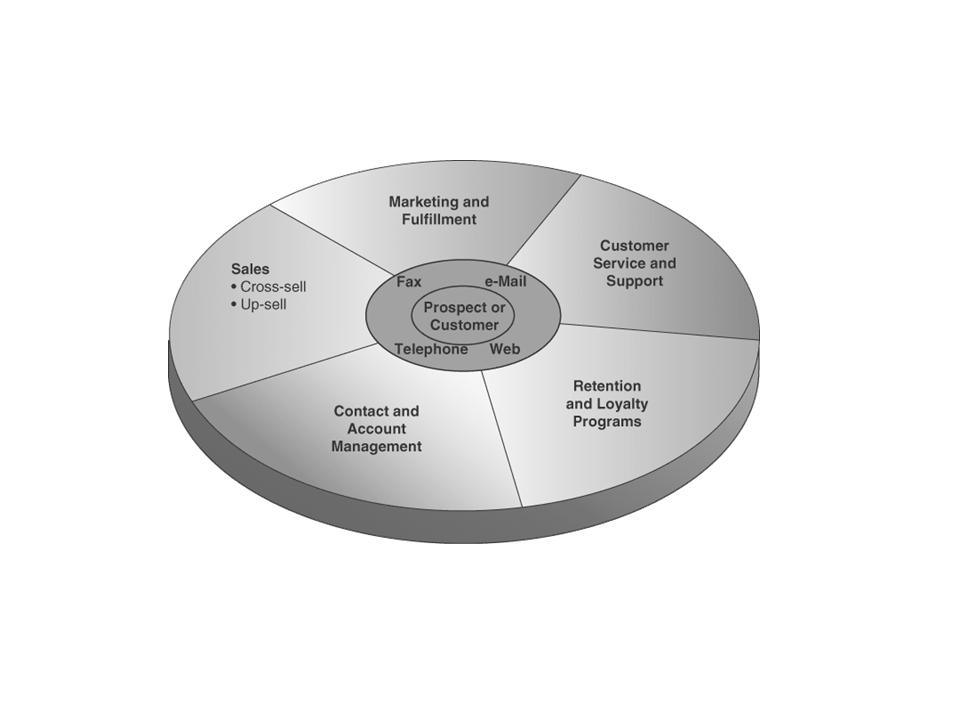Customer Relationship Management
While many companies strive to be "customer-centric" very few have been able to completely focus every functional area on the customer. Largely due to the new avenues of information customers have through the Internet, organizations must fight harder to keep the customers they work so hard to get in the first place. Customer Relationship Management (CRM) use information technology to create a cross functional enterprise system that integrates and automates many of the customer serving processes in sales, marketing and customer service that interact with a company’ s customers.
Customer Relationship Management and Partner Relationship Management
The goals of customer relationship management systems are to optimize:
- revenue
- profitability
- customer satisfaction
- customer retention
Partner relationship management systems are a reflection of internal customer relationship management systems but extend past the immediate borders of a firm to its selling partners. For instance, Levi Jeans doesn't sell directly to its customer but rather through other retail outlets. How Levi's partners cater to the customer directly affects its profitability. Therefore, Levi is very interested in sharing information about its customers with its partners to increase sales of its products. Using partner relationship management systems not only helps Levi but also its retailers.
Customer Relationship Management Applications
Many companies are overloaded with data about customers. Unfortunately, the companies don't have any useful information that can help them increase customer satisfaction and retention, thereby increasing revenues and profitability. The ability to turn raw data into useful information is where CRM systems shine. CRM systems can gather customer information from all corners of a business, consolidate the information and then provide it to the customer touch points. By offering a consolidated viewpoint of the customer to these touch points, a company can cater to the customer that offers the most profitability.
Financial institutions are a prime example of how effective CRM systems can be to help identify the customers that offer the most "bang for the buck." Most of the larger banks offer more than just current and savings accounts. They provide investment services, insurance policies, and loans. It's much cheaper for Stanbic bank for instance, to provide its current customers with all of these financial products, rather than trying to attract new customers for each of the product lines. Information gleaned from a CRM system can provide Stanbic with information about which customers are more likely to purchase these products and the sales force can target that market better.
Customer Relationship Management (CRM) Software
CRM application software ranges in size and complexity making it possible for an organization to select the type of software it needs the most. Modules focusing on partner relationship management or employee relationship management can be integrated into the customer relationship management software at a later date. Figure 7 shows some of the major application clusters in CRM.

Figures 7 the major application clusters in CRM (Source O’Brien & Marakas)
Some of the more common capabilities of CRM software are:
- Sales force automation: allows the sales force to focus on the most profitable customer. It also reduces the cost per sale for acquiring new customers and retaining old ones.
- Customer service: gathers information from a variety of sources and makes it available across organizational functions so that data is input only once.
- Marketing: Allows companies to engage in cross-selling, up-selling, and bundling through better analysis of customer data.
Operational and Analytical CRM
It's important to understand the difference between the operational and analytical aspects of CRM systems. Operational CRM includes everything a company should provide those employees who interface directly or indirectly with the customer: the sales force, call centers, and support activities. Managers and decision makers would use the analytical CRM to help them improve business performance. The analytical CRM uses data from the operational CRM and provides managers with the opportunity to target smaller, specific customer groups or market segmentation. Rather than trying to blanket a huge group of potential customers, many of whom are not interested, managers use the analytical CRM to focus their efforts on those customers who can offer the most profit at the least cost.
Business Value of CRM systems
CRM software will help managers better understand their customers thereby helping them make better decisions about product lines and marketing campaigns. CRM systems can also help reduce the customer churn rate and identify which customers are most profitable. Hopefully CRM will help them discover which half of the ad budget is wasted.
Once again, the benefits of using CRM systems are worth the challenges you'll face.
Benefits:
- Increased customer satisfaction
- Reduced marketing costs
- More effective marketing
- Lower costs for customer acquisition and retention
- Increased sales revenue
- Better response to customer needs
The Importance of CRM Performance Measurement
We introduced the importance of using metrics to measure the effectiveness of implementing supply chain management systems in the last section. Effective implementation of CRM systems also requires the use of metrics to determine the return on investment of the new system. One of the most important metrics is the customer lifetime value (CLTV). Remember, it costs six times more to gain a new customer than to keep an old one. By measuring the CLTV of customers, organizations can calculate customer profitability and determine which customers they should cater to.
In conclusion, customer relationship management systems allow a firm to focus all of their energy and attention on developing profitable customers and forgoing unprofitable ones. Useful information produced by CRM systems allow firms to improve business performance while reducing costs associated with gaining and retaining customers. Information can be shared internally and externally. Fundamental changes in the organizational culture and business processes are a must